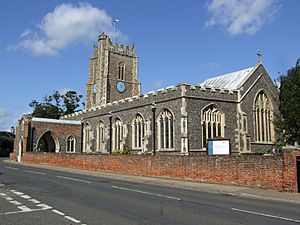St Peter and St Paul's Church, Aldeburgh facts for kids
Quick facts for kids St Peter and St Paul's Church, Aldeburgh |
|
|---|---|

St Peter and St Paul's Church, Aldeburgh
|
|
| 52°09′18″N 1°36′00″E / 52.154952°N 1.5999055°E | |
| Location | Aldeburgh |
| Country | England |
| Denomination | Church of England |
| History | |
| Dedication | St Peter and St Paul |
| Architecture | |
| Heritage designation | Grade II* listed |
| Administration | |
| Parish | Aldeburgh with Hazlewood |
| Deanery | Saxmundham |
| Archdeaconry | Archdeaconry of Suffolk |
| Diocese | Diocese of St Edmundsbury and Ipswich |
| Province | Province of Canterbury |
St Peter and St Paul's Church in Aldeburgh, Suffolk, is a historic church that has been an important part of the town for centuries. It is a Grade II* listed building, which means it is a very special and important historical site. The church is dedicated to two important saints, St Peter and St Paul.
Contents
A Look at the Church's History
The oldest part of St Peter and St Paul's Church is its tower, which was built in the 1300s. Most of the church you see today was built later, in the 1500s. For example, the main part of the church, called the nave, and the north side sections were built between 1525 and 1529. The south side sections were added a few years later, from 1534 to 1535. The entrance porch on the south side was completed in 1539, and the chancel, which is the area around the altar, was finished in 1545.
The church has been carefully looked after over the years. It was repaired and updated between 1870 and 1871, and again in 1891. These updates helped to keep the church strong and beautiful for future generations.
The Church Bells
St Peter and St Paul's Church has a set of eight bells that can be rung together. Most of these bells were made by a company called John Taylor & Co in 1960 and 1961. This was part of a big project to fix up the bells and add more to the church. The newly restored bells were officially blessed on June 18, 1961.
Before this, the church had six bells. These were rehung in 1885, and one bell was remade while another was added to make a set of six. The bells hang in a strong wooden frame made from iroko wood. This frame was put in place when the bells were updated in the 1960s.
People who are part of the Suffolk Guild of Ringers often ring the bells. They perform long ringing sequences called "peals," which can last about three hours. These peals happen most months.
| Bell | Date | Note | Diameter | Founder | Weight | ||
|---|---|---|---|---|---|---|---|
| long measure | lb | kg | |||||
| Treble | 1961 | Ab | 23.50 in (59.7 cm) | John Taylor & Co | 3 long cwt 0 qr 20 lb | 356 | 161 |
| 2nd | 1961 | G | 24.50 in (62.2 cm) | John Taylor & Co | 3 long cwt 1 qr 25 lb | 389 | 176 |
| 3rd | 1960 | F | 26.00 in (66.0 cm) | John Taylor & Co | 3 long cwt 3 qr 21 lb | 441 | 200 |
| 4th | 1960 | Eb | 27.50 in (69.9 cm) | John Taylor & Co | 4 long cwt 2 qr 2 lb | 506 | 230 |
| 5th | 1622 | Db | 28.50 in (72.4 cm) | William & John II Brend | 4 long cwt 1 qr 7 lb | 483 | 219 |
| 6th | 1913 | C | 31.13 in (79.1 cm) | John Taylor & Co | 6 long cwt 0 qr 4 lb | 676 | 307 |
| 7th | 1913 | Bb | 35.00 in (88.9 cm) | John Taylor & Co | 8 long cwt 2 qr 1 lb | 953 | 432 |
| Tenor | 1960 | Ab | 39.13 in (99.4 cm) | John Taylor & Co | 11 long cwt 2 qr 20 lb | 1,308 | 593 |
Famous People Remembered Here
The church is home to several memorials for important people. There is a memorial for the poet George Crabbe, who passed away in 1832. Another monument remembers Lady Henrietta Vernon, who died in 1786.
St Peter and St Paul's Church is especially well-known because it is the burial place of the famous composer Benjamin Britten and his partner, the singer Peter Pears. Many other notable people are also buried in the churchyard. These include the pioneering doctor Elizabeth Garrett Anderson, the opera singer Joan Cross, and the composer and conductor Imogen Holst.
Benjamin Britten is also honored with a beautiful stained glass window in the church. This window was created by artists John Piper and Patrick Reyntiens. The church also has a memorial for Newson Garrett and his wife, who were Elizabeth Garrett Anderson's parents.
The Church Organ
The church has a pipe organ with two keyboards, built by J. W. Walker & Sons Ltd in 1884. This organ provides music for services and events at the church. You can find more details about this organ on the National Pipe Organ Register.
Images for kids
-
Grave of Benjamin Britten
-
Adjoining grave of Sir Peter Pears



